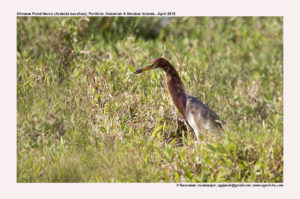Chinese Pond Heron

Chinese Pond Heron Ardeola bacchus
Etymology :
- Ardeola : Latin word for heron derived from ardea- heron
- Bacchus: Latin word for wine derived from Roman mythology – Bacchus, son of Jupiter and god of wine
Vernacular Names : Mani: Lampra
Distribution in India: Resident of North East and Andaman Islands in India.
Description: Size of 42–52 cm; wt. of 280–332 g; wingspan of 79–90 cm. In breeding plumage it has darker head and upper breast, and has rufous crest plumes. The upper back has long blackish plumes that extend beyond tail, while the wings, rest of upperparts, throat and belly are white. The breast has long maroon plumes and there are long dark grey plumes on the pectoral region. The female differs from male in paler foreneck, shorter plumes, lack of slaty patch on breast and browner scapulars and tertials. For both during courtship legs become intense pinkish red, at other times yellowish; bill is yellow with bluish base and black tip in breeding season, maxilla is dusky in non-breeding season, eyes are golden-yellow and facial skin is greenish yellow including pale eyering. The non-breeding adult is similar to congeners, but has darker back and tips to primaries. The juvenile is brown, heavily streaked buff and dark brown; underparts are whitish with heavy brown streaking. The first-winter plumage has streaked lesser wing-coverts (versus plain white in adults) and more extensively brown outer primaries and tail tip. The first-summer plumage reported to be very similar to that of adult, duller overall with some streaking on head and neck.
Habitat: It is found in paddy fields, swamps, ponds, riverbanks; also in mangroves and at tidal pools, mainly in lowlands. It is found usually up to 1450m but in migration can reach up to 4000m.
Food habits: It eats small frogs, worms, aquatic invertebrates, fish, molluscs, worms, some terrestrial insects and even small birds. It hunts by standing and walking slowly, as well as Feet First Diving, Hovering and Dipping. It also feeds on the wing and feeds with otters.It feeds more around dawn and dusk than in rest of day. It is found solitary or in pairs, sometimes in small flocks.
Breeding habits: They breed in India, May–Aug; in China, from Apr–Jul; in Hunan in May. They are colonial, normally forming small colonies, sometimes with other herons. They nest high in trees, also nests in bamboos and mangroves. The nest is a small stick nest sometimes lined with leaves and grass. They are double-brooded, with second clutch typically laid after young from first clutch have become independent. They lay a clutch of 4–6 eggs. The incubation period is 18–22 days. The incubation is done by both adults. The fledging period is 30 days and chicks become independent six days later. Mynas steal food from chicks.